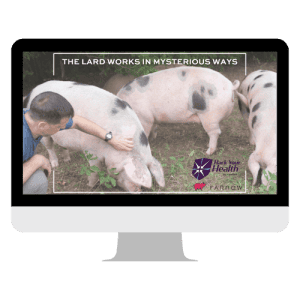
Austin Texas was amazing. The Hack Your Health conference delivered amazing speakers and practitioners from the Carnivore, Keto, and Fasting communities. My presentation titled “The Lard Works in Mysterious Ways” landed well and the feedback was so inspiring.
I wanted to take a moment to share a portion of the talk that seemed to really resonate with the audience. They were clamoring for more information, and it seemed appropriate to share that unpacking with you all.
Skincare is a Fat-based Business.
The vast majority of skin treatments for millennia have been some compounding of fat. Today, we see the skincare world dominated by a combination of petroleum derivatives, seed oils, and plant-based fats. One of the concepts espoused by Ann Weldon of Holy Cow Beef during our regenerative agriculture panel on Friday was the idea of “Good/Better/Best” choices when it comes to food and meat.
It was during that panel that I offered up an addition to the choice matrix— you have to include Bad choices in the equation. Applying that skincare, I would make the following assertions regarding the fats in skincare:
Bad Fats for Skin:
Petroleum derived products (petrolatum being the most common). We must also throw Seed Oils in this category—despite the researching being early…these fats have only existed for likely the last 60-80 years. They are naturally occurring, however the process by which we extract them is beyond toxic and they are riddled with potential health issues for humans whether digesting through the gut or the skin. Unfortunately, these fats comprise well over 50% of the ingredients used in skincare today.
Good Fats for Skin:
Plant-based fats from the fruit if the plant (not the seed). A short list of examples here would be olive oil, coconut oil, and shea butter. Important to point out that these fats are “good for the skin” primarily when compared to the petroleum/seed-oil based fats so common in the marketplace.
Better Fats for Skin:
Both visceral and subcutaneous fat from a ruminant animal. Today, this is most commonly beef tallow. Tallow comes from the visceral fat of a ruminant herbivorous animal (deer, beef, bison, elk, goat, sheep, etc). We don’t really see a presence of ruminant subcutaneous fat in
skincare—most of that fat is used to provide fat that is incorporated into the ground meat of that animal. A WAY better choice than petroleum, seed oils, or plant-based fats…but still not entirely aligned with human biology. After all, we are not ruminant animals. Saying that, we LOVE tallow and use it in our products. It is less absorbable by our skin than lard, so it acts as a sealer once the lard has soaked in thoroughly.

Best Fats for Skin:
The most efficacious fat for human skin will come from a healthy omnivorous mammal. In our current food system, the only animal that foots this bill is the Pig. Unfortunately, most pigs in the US (and likely globally) are raised in abhorrent conditions and fed a very poor diet. Lard is the rendered subcutaneous fat from a pig. Leaf Lard is the rendered visceral fat from a pig. We use both in our products and this is why our phone continues to ring off the hook from our customers telling us that their skin has never looked or felt better. Lard is the closest substance on the planet to human sebum (the oil our glands produce), making it an ideal fat to feed and nourish skin.
During the three days of Hack Your Health, Brandon tried our product every single day. He would come by for another lathering each morning and afternoon. By Sunday, the psoriasis on his hands had completely resolved. Rather fascinating and absolutely warmed our hearts knowing that our SmartLard™ was able to resolve his issues. Brandon is one of MANY folks that have seen the power of the Lard work miracles in their lives.




